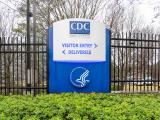Sep 17, 2009 (CIDRAP News) – A study in which N95 respirators strongly outperformed surgical masks in shielding hospital workers from influenza viruses and other microbes is being hailed as a landmark in research on respiratory protection for healthcare workers.
The study, which involved close to 2,000 hospital staffers in Beijing, showed that N95 respirators reduced the risk of respiratory illness by a significant 60% and the risk of confirmed influenza by 75%, whereas surgical masks had no effect.
The study was reported at an American Society for Microbiology meeting in San Francisco this week but has not yet been published in full form. It is described as the first randomized controlled trial comparing the effectiveness of N95 respirators and surgical masks.
N95 respirators are designed to fit closely to the face and filter out 95% of airborne particles, whereas surgical masks are looser fitting and were originally designed to prevent the wearer from infecting others.
But health workers say the tight-fitting N95s are uncomfortable and difficult to wear for long periods, and hospitals sometimes have trouble keeping them in supply. Surgical masks are more comfortable and cheaper, but scientists have not found much evidence that they protect wearers from respiratory pathogens.
In the face of the H1N1 flu pandemic, respiratory protection for health workers has been a big issue. Two weeks ago, the National Academy of Sciences' Institute of Medicine (IOM) issued a report affirming the current Centers for Disease Control and Prevention (CDC) guidance on the topic. The CDC recommends use of N95s by all healthcare workers who enter the rooms of patients with confirmed or suspected H1N1 infection. The same advice goes for emergency medical personnel who come in close contact with such patients.
But the CDC is expected to issue some new guidance on the issue soon. CDC spokesman Tom Skinner said today that the new recommendations will be issued "by next week at the latest."
China chosen for good reason
The IOM report said few studies have compared N95 respirators and surgical masks in clinical use. The new study, conducted by an international team led by Raina MacIntyre of the University of New South Wales in Australia, was designed to help fill that gap.
The authors picked China as the study site because they wanted a place where hospital workers are used to wearing respiratory protection and thus would be likely to comply with the study protocol, MacIntyre told an IOM committee at a workshop in August. She said Asians are much more used to wearing face protection than their counterparts in the West.
The researchers recruited 1,936 front-line workers at 24 Beijing hospitals, according to the study abstract from the Interscience Conference on Antimicrobials and Chemotherapy (ICAAC). They were assigned to one of four groups: surgical masks, fit-tested N95s, non-fit-tested N95s, or control (no respiratory protection). The volunteers wore their assigned form of protection for 4 weeks and were monitored for illness for 5 weeks.
The authors found that surgical masks had no protective effect. In contrast, the N95s, compared with the controls, were linked with a 60% reduction in risk for any respiratory illness, a 75% reduction in flu-like illness, a 56% decrease in lab-confirmed respiratory illness, and a 75% reduction in confirmed flu, according to the report. The reductions met the test of statistical significance.
However, the researchers found that fit-testing of the N95s—recommended by manufacturers to keep air from leaking around them—made no difference in protection.
"These data are the first clinical data to confirm the superiority of N95 masks in preventing respiratory infections," the authors state in their abstract. "Front line health workers are key to an effective pandemic response, and should be protected with N95 masks."
Concerning the finding that fit-testing doesn't improve the effectiveness of N95s, they also say, "Given the logistic difficulties of fit testing, particularly during an infectious diseases emergency, this is an advantage for public health control."
Study wins praise
Lisa Brosseau, a University of Minnesota researcher who has studied respiratory protection for years, agreed with the initial assessment by others, reported in the media, that the MacIntyre study is a major achievement in the field.
"It is a landmark study," she said. "I was very excited to hear it, because doing a clinical study comparing surgical masks and respirators is not an easy thing to do," said Brosseau, an associate professor in the environmental sciences division of the university's School of Public Health. "China is one of the only places where people would be willing to wear a respirator all the way through the day."
"It's hard to comment conclusively before reading the [full] paper, but based on her [MacIntyre's] presentation and the data she's given us, it's a pretty clear conclusion that surgical masks do not offer protection, which is not very surprising based on the literature I've seen," she said.
Brosseau said that as the name suggests, surgical masks were originally designed to be worn by surgical teams to protect the surgical field from contamination. "But then they started being worn in many more settings," encouraging an impression that they protect wearers, she said.
MacIntyre's study "illustrates how there is no protection from surgical masks, so I hope it'll discourage people from saying there is protection," Brosseau said.
She said a few studies, particularly related to SARS (severe acute respiratory syndrome) in Asia and Canada, have seemed to show that surgical masks helped protect wearers from respiratory infections, but she called the findings questionable.
"There's a really big problem with retrospective studies," she said. "How do you know that people really did wear those masks, and how much do you know about their exposure? Really in the end, what it's arguing is that putting anything on your face is an improvement over putting nothing on your face."
As for the finding that fit-testing made no difference in benefits from the N95s, Brosseau suggested a possible explanation. She said MacIntyre told the IOM committee at the August workshop that her team used an N95 specially designed by 3M Co. for the Chinese face and that fewer than 5% of volunteers failed to pass the fit test. "Thus, this is a mask that is likely to fit most adults in the Chinese population very well, which is why fit testing did not make a significant difference in the rates of disease," Brosseau said.
MacIntyre C, Wang Q, Cauchemez S, et al. The first randomized, controlled clinical trial of surgical masks compared to fit-tested and non-fit-tested N95 masks in prevention of respiratory virus infection in hospital health care workers in Beijing, China. Presented Sep 15, 200, at ICAAC meeting, San Francisco (Abstract accessible through ICAAC meeting search page)
See also:
Sep 3 CIDRAP News story "IOM affirms CDC guidance on N95 use in H1N1 setting"
Aug 12 CIDRAP News story "IOM hears diverse findings on PPE for flu"


















